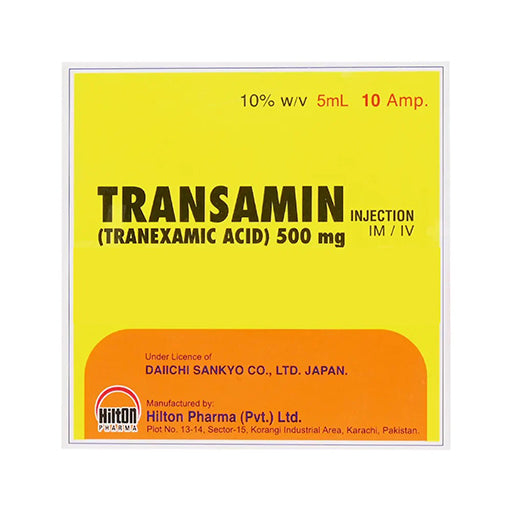Your cart is currently empty.
Transamin 500 mg / 5 ml Injection – Box of 10 Ampoules
: Available:
QUESTIONS & ANSWERS
Have a Question?
Be the first to ask a question about this.
Category:

Description
Transamin injection (tranexamic acid) is an antifibrinolytic agent used to reduce or prevent excessive bleeding. It works by inhibiting the conversion of plasminogen to plasmin, thereby stabilizing formed blood clots and preventing their breakdown (fibrinolysis).
Ingredients
-
Active ingredient: Tranexamic Acid (equivalent to 500 mg per 5 ml)
-
Excipients / inactive ingredients: (typical injection excipients such as water for injection, buffering agents, stabilizers) — specific excipients depend on manufacturer
Drug Class
Antifibrinolytic / Hemostatic agent
Dosage Form
Sterile injection (aqueous solution) — 5 ml ampoule delivering 500 mg tranexamic acid
Uses (Indications)
Transamin injection is used in conditions involving excessive bleeding or bleeding risk, such as:
-
To reduce bleeding during or after surgery, trauma, or in surgical procedures
-
Heavy menstrual bleeding (menorrhagia) when other measures are inadequate
-
Postpartum hemorrhage (bleeding after childbirth)
-
Control of bleeding in dental surgeries, hemophilia, or other bleeding disorders
-
To control bleeding from the gastrointestinal tract or other internal bleeding settings (depending on clinical decision)
Dosage
-
The dose and frequency depend on the severity of bleeding, patient condition, and medical advice.
-
In many clinical settings, the injection is administered intravenously (IV) slowly or intramuscular (IM) as needed under supervision.
-
The dose may be repeated or maintained as per the physician’s protocol.
In Case of Overdose
-
Symptoms may include nausea, vomiting, diarrhea, hypotension, seizures in severe cases
-
Management should be supportive and symptomatic, with monitoring of vital signs and appropriate medical care.
Missed Dose
-
Because injection is administered in clinical settings, “missed dose” is not commonly applicable to patient self-administration.
-
Any discrepancy in dosing should be handled by the treating healthcare provider.
How To Use / Administration
-
Administer slow IV injection or IM under aseptic conditions.
-
IV route is preferred in many instances to ensure controlled delivery and reduce risks.
-
The injection should be given slowly to avoid hemodynamic or adverse effects.
-
Monitor patient during and after injection for reactions and bleeding control.
When Not to Use (Contraindications)
-
Known hypersensitivity to tranexamic acid or any components of the formulation
-
Active thromboembolic disease (e.g. deep vein thrombosis, pulmonary embolism) or history of clotting disorders
-
Hematuria (significant blood in urine) or bleeding in urinary tract may worsen clots in unwanted places
-
Pregnancy and breastfeeding: use only if benefits outweigh risks (caution)
-
Patients with a history of seizures should take caution, as tranexamic acid has been associated with risk in some reports
Side Effects
Common / Less Serious:
-
Dizziness, lightheadedness
-
Skin rash, itching or local reactions
Rare / Serious:
-
Thromboembolic events (blood clots) in predisposed patients
-
Changes in color vision or visual disturbances
-
Allergic reactions (swelling, breathing difficulty)
Precautions & Warnings
-
Use caution in patients with renal impairment, history of clotting disorders, cardiovascular disease
-
Monitor kidney function, clotting status, and signs of thrombosis
-
In prolonged therapy, observe for adverse effects
-
Avoid combining with other agents that increase clotting risk unless under close supervision
-
Use the lowest effective dose for shortest possible duration
-
Inform physicians/dentists of use of tranexamic acid prior to surgery or invasive procedures
-
In patients with seizure history, caution is advised
Drug Interactions
-
Use with combined hormonal contraceptives or estrogens may increase clotting risk
-
Concurrent use with oral anticoagulants or thrombolytics requires caution and medical supervision
-
Other agents affecting clotting or fibrinolysis may interact (increasing or reducing effect)
Storage / Disposal
-
Store at room temperature in a dry place, protect from direct sunlight
-
Do not freeze
-
Use before expiry date
-
Dispose of unused or expired ampoules following biomedical waste guidelines
Control Drug Status
-
Tranexamic acid is not a controlled narcotic, but it is a prescription medicine that must be used under medical supervision
Quick Tips
-
Administer slowly when given IV to reduce adverse reactions
-
Monitor for signs of clotting or thrombosis, especially in high-risk patients
-
Avoid use in patients with thrombotic history
-
Use minimal effective dose for shortest time
-
Always consult a physician before using during pregnancy or lactation
-
Ensure proper renal function before use
Your order of 100$ or more gets free standard delivery.
- Standard delivered 4-5 Business Days
- Express delivered 2-4 Business Days
Orders are processed and delivered Monday-Friday (excluding public holidays)
eMarket members enjoy free returns.
Related Products

Categories
Custom HTML Text
-
Free Delivery
From Rs 5000
-
Support 24/7
Online 24 hours
-
Free return
365 a day
- Choosing a selection results in a full page refresh.
Added to cart successfully. What's next?

Product type: 1
1 x $00.00






















 Chat with Us
Chat with Us